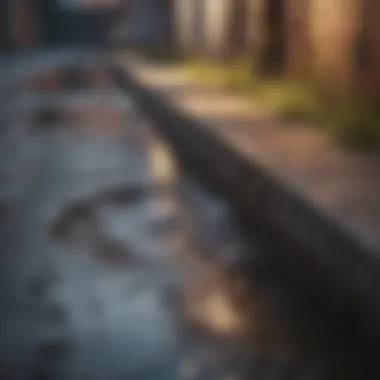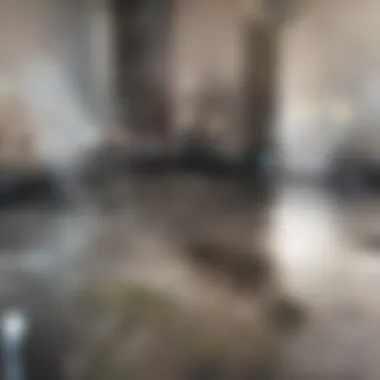How to Unblock a Sewage Drain Outside: A Practical Guide


Intro
Blocked sewage drains outside can lead to unpleasant situations and potential property damage. Understanding this issue is critical for homeowners. Blockages can occur due to various reasons, including debris accumulation, tree roots, or grease buildup. Knowing how to address these problems can prevent larger issues down the road.
This guide will explore practical techniques for unblocking sewage drains, highlight essential tools to have on hand, and provide preventative measures to maintain proper drainage. For those interested in property upkeep, this article serves as a valuable resource.
Common Causes of Sewage Drain Blockages
Before tackling the issue, it’s important to identify common causes of blockages:
- Debris Accumulation: Leaves, dirt, and litter can gather in drains.
- Tree Roots: Roots may infiltrate pipes, causing serious damage.
- Grease Buildup: Pouring fats down the drain leads to clogs.
- Foreign Objects: Items like toys or sanitary products can block the flow.
Recognizing these causes can assist in effective prevention and maintenance strategies.
Step-by-Step Unblocking Procedures
1. Assess the Situation
Begin by evaluating the blockage. Look for signs of standing water or unpleasant odors. This can indicate a blockage that needs further attention.
2. Gather Necessary Tools
Important tools to have are:
- A plunger
- A plumber’s snake
- A pressure washer
- Drain cleaning chemicals (safely used)
3. Use a Plunger
Apply the plunger over the drain. Ensure a good seal and push down firmly. The pressure generated will help break up minor clogs.
4. Employ a Plumber’s Snake
If plunging fails, use a plumber’s snake. Insert it into the drain and twist. This method can reach clogs deeper in the system.
5. Chemical Cleaners (Optional)
As a last resort, chemical cleaners can be considered. Always follow instructions and ensure safety measures are in place.
Regular maintenance can prevent blockages and enhance the longevity of your drainage system.
Maintenance Tips
To keep drains running smoothly, consider these maintenance tips:
- Conduct regular checks for debris.
- Avoid pouring grease down kitchen sinks.
- Use drain covers to catch leaves and large debris.
- Schedule professional inspections when necessary.
Implementing these practices will help guard against future issues, ensuring reliable drainage.
Epilogue
Understanding how to unblock sewage drains effectively can save time and money. Keeping drains clear of debris, roots, and grease is essential. Overall, regular maintenance should not be neglected. By following the methods described, homeowners can take charge and protect their property from potential drainage issues. For more tips and information, consider exploring resources like Wikipedia or Reddit.
Understanding Sewage Drain Blockages
Understanding sewage drain blockages is vital for maintaining efficient drainage systems. Such blockages can lead not only to unpleasant odors but also to significant damage to your property and surrounding environment. Recognizing the factors that contribute to these issues helps homeowners take proactive steps to prevent them. In this section, we will explore what sewage drains are, the common causes of blockages, and their implications.
What is a Sewage Drain?
A sewage drain is a crucial component of a property’s plumbing system. It serves to transport waste and wastewater from households to treatment facilities or septic tanks. Proper functioning of sewage drains is essential to avoid health hazards and maintain hygiene. Understanding its role helps underscore the importance of keeping it clear, as any obstruction can cause a cascade of problems, from minor annoyances to major health risks.
Common Causes of Drain Blockages
Several factors can cause sewage drains to become blocked. Understanding them is crucial for effective management. Here, we discuss the most common reasons for these blockages:


Accumulation of Debris
Accumulation of debris is a common cause of blockages. Organic matter, dirt, paper, and other materials can build up over time. This accumulation narrows the passage in the drain, ultimately leading to backups. Regular inspection and cleaning are beneficial strategies to prevent this buildup.
To maintain functionality, it's important to remove visible debris regularly. Neglect can lead to more severe issues, exacerbating blockages and increasing repair costs.
Tree Roots Infiltration
Tree roots infiltration occurs when roots from nearby trees grow into sewage lines, drawn by moisture and nutrients. This can compromise the integrity of the pipes, leading to significant blockages. Once roots infiltrate, they can create a tangled web that restricts the flow of waste, making removal difficult. This issue is particularly prevalent in older plumbing systems.
To counteract this problem, regular maintenance is necessary. Plants should be monitored, and preventive measures taken to ensure their roots do not encroach on underground systems.
Grease and Fat Build-Up
Grease and fat buildup is another frequent cause of blockages in sewer lines. When cooking oils and fats are washed down drains, they cool and solidify, forming a sticky coating inside the pipes. This coating can trap other debris and lead to severe clogs. It is a well-known fact among homeowners that regular cleaning can prevent buildup, reducing the risk of blockages.
Avoiding dumping fats down the drain is a simple preventive measure. Instead, disposing of them in waste containers can help maintain the drain's functionality.
Foreign Objects
Foreign objects are often a surprising cause of drain blockages. Items such as cleaning wipes, toys, or even menstrual products can easily find their way into drains, leading to unexpected issues. These objects can become stuck in bends and corners, creating major clogs that disrupt normal flow.
Education is key in preventing these issues. Homeowners should be mindful of what enters their drainage system and enforce rules against flushing or disposing of inappropriate materials.
Identifying Blockage Symptoms
Understanding the symptoms of a blocked sewage drain is crucial for effective remediation. Early recognition can prevent more significant issues, such as extensive damage to your property or costly repairs. By being aware of the warning signs, homeowners can take action before a minor problem escalates into a major inconvenience. This section discusses specific symptoms to lookout for when dealing with potential drainage issues.
Slow Drainage
One of the primary signs that a sewage drain is blocked is slow drainage. Water may take longer than usual to flow down the drain, leading to pooling or a sluggish experience in various fixtures of your property. This can be particularly frustrating in sinks and bathtubs, where standing water may be noticeable.
Slow drainage often indicates a buildup of debris within the pipes or the beginning stages of a more severe blockage. Homeowners should monitor this symptom closely, as ignoring it might lead to complete drainage failure. Maintaining a watchful eye on these signs can facilitate timely intervention.
Unpleasant Odors
Another symptom of a potential blockage is the presence of unpleasant odors emanating from drains or the surrounding area. Foul smells can indicate decomposing waste or stagnant water trapped within the sewage system. These odors not only create a disadvantage in living conditions but can also signal deeper issues within the plumbing.
It is important to address these odors quickly. Ignoring them can lead to health concerns due to bacteria and other pathogens possibly accumulating in standing water. Ventilation is also a consideration; if an area feels stuffy or unclean, it may relate directly back to blocked drains.
Gurgling Noises
Gurgling noises that come from plumbing fixtures can also signal a sewage drain issue. These sounds often occur when air is trapped and trying to escape through the water, causing odd noises as it bubbles up. Gurgling primarily signifies that air cannot move freely through the pipes due to a blockage.
This symptom warrants immediate attention. Neglecting a gurgling sound could mean the blockage is worsening, eventually leading to further complications or complete drainage failure.
Flooding or Standing Water
Flooding or standing water near the sewage drain is one of the more obvious indicators of a blockage. This situation is critical since it not only obstructs normal use but can lead to property damage and create hazards.
It is essential to address any noticeable pooling of water. Homeowners might find this around the drainage site or even within basements if the sewage is routed there. Standing water presents numerous issues, such as attracting pests or breeding mosquitoes, which further complicates the situation.
The presence of flooding is often the most urgent sign of a sewage drain blockage. Act quickly to minimize potential damage.
Understanding these symptoms equips homeowners to handle potential sewage drain issues more effectively. Recognizing them can save time, stress, and money in the long run.
Initial Inspection of the Drain
The initial inspection of the drainage system outside your home is creitcal to understanding the scope of any blockage problem. This step allows the home owner to assess what might be clogging the system and which tools or methods will be necessary for effective resolution. This approach can prevent further damage or complications, as improper handling may exacerbate the issue, lead to further blockage, or even result in overflow situations. Conducting a thorough inspection helps identify the specifc symptoms present, such as signs of corrosion, root overgrowth, or even accumulated waste.
To ensure that you address the problem comprehensively, it is necessary to conduct a systematic examination and gather appropriate tools.
Gathering Required Tools


When tackling a sewage drain blockage, having the right tools at your disposal simplifies the process and increases your chances of success. Below are essential tools you will need:
Plumber's Snake
A plumber's snake is a must-have tool for clearing drains. It consists of a long flexible wire with a coiled end that can navigate through the pipes. Its primary function is to reach deep into the drainage system and dislodge any debris causing blockages. One of its key characteristics is its extendable length, making it versatile for various lengths of pipes. This tool is a popular choice because it can handle various types of clogs, from hair to food particles.
However, using a plumber's snake requires care. If not used correctly, it can damage the plumbing. The effectiveness of this tool is dependent on the severity and type of blockage present.
Drain Auger
The drain auger is another effective tool for tackling blockages in an outside sewage drain. It features a long, flexible cable that is designed to break up and remove clogs, especially stubborn ones caused by tree roots. The key characteristic of a drain auger is its power to penetrate deeper obstructions that a plumber's snake might not reach. This tool is favored for its strength and durability.
Its unique feature lies in the rotating head, which helps to break down tough clogs. Yet, it may require a little more skill to operate effectively. Improper use can lead to damage or may not effectively clear the blockage.
Rubber Gloves
Protective gear is essential during any plumbing task, and rubber gloves are top choice for working with sewage drains. They provide a barrier against harmful bacteria and other pathogens present in the system. Their key feature is the waterproof material, which ensures safety during exposure to messy situations.
Wearing these gloves is a simple yet important precaution. They allow you to maneuver through potentially contaminated areas without direct skin contact. Nevertheless, rubber gloves can wear out. Ensure that they fit well and are free from tears to maximize protection.
Bucket
A bucket is often overlooked, but it plays a significant role in dealing with blockages. It serves multiple purposes: first, to catch any waste materials during the unclogging process, and second, to hold water or cleaning solutions. A bucket’s key characteristic is its capacity to store liquid or debris safely. It is practical since it makes cleanup easier, preventing debris from spilling onto the ground.
Although basic, this tool has its advantages. It is light, easy to handle, and inexpensive. However, it does not have any special features, so overloading it can make it cumbersome. Choose one that is sufficiently sturdy to endure the cleaning process.
Visual Inspection Techniques
Performing a visual inspection is a pivotal step to understand the nature of the blockage. Start by looking for signs of leaks, overflows, or unusual water pooling nearby. Remove any visible debris around the drain that may affect drainage flow. Checking for cracks or structural issues in the drain is equally important. Positioning a flashlight near the drain can also help you see inside better. By gathering information in this way, you create an excellent foundation for the next steps in addressing the blockage.
Methods to Unblock an Outside Sewage Drain
Unblocking an outside sewage drain is an essential task that homeowners may face. Such tasks are crucial to maintain the hygiene and safety of one’s property. Blockages can lead to unpleasant odors, slow drainage, or even flooding. Thus, understanding how to effectively unblock these drains can save considerable time and money. This section will cover various methods to restore proper drainage, detailing practical techniques and the tools needed for each approach.
Manual Removal of Debris
One of the simplest yet effective methods for unblocking a sewage drain is the manual removal of debris. This method entails inspecting the drain for visible blockages. If the blockage is near the surface, it may be possible to remove it by hand with gloves. This method is particularly beneficial as it does not require special tools and is an immediate solution to minor blockages. However, it is essential to take safety precautions and avoid direct contact with sewage.
Using a Plumber’s Snake
A plumber’s snake is a flexible tool used to break through clogs in drains.
Step-by-Step Guide
- Insert the snake: Feed the snake into the drain until you feel resistance.
- Rotate the handle: Turn the handle to break up the clog. The rotation helps the snake grab hold of the blockage.
- Pull back the snake: Once you feel the resistance lessening, carefully remove the snake from the drain to see if debris has come out.
The plumber's snake is a popular choice for many homeowners due to its efficiency and ability to reach deeper clogs. It is less harsh than other methods, such as chemical cleaners, thus making it a favored option. However, one must be cautious while using it to avoid damaging the plumbing system.
Applying a Drain Auger
A drain auger is a more robust tool that resembles a plumber’s snake, but it is designed specifically for tougher clogs.
How to Use Effectively
- Insert the auger: Place the end of the auger into the drain until it hits the blockage.
- Crank the handle: Turn the crank to allow the auger to penetrate and break up the clog.
- Retrieve debris: Pull out the tool to remove any muck that may be attached to the auger’s end.
Using a drain auger can effectively clear larger obstructions you might encounter. Its design allows for deeper penetration into the plumbing, making it suitable for stubborn blockages. However, the learning curve can be steeper than that of a plumber's snake. Users may need practice to master its operation without causing damage.
The Hot Water Approach
Another method for unblocking a sewage drain is utilizing hot water. This technique works especially well for grease or soap-rich clogs. Pouring hot water into the drain can help dissolve these materials, breaking down the blockage. Caution should be taken to ensure that the pipes can withstand high temperatures. It's a low-cost and simple solution that often yields positive results, but may not be effective for all types of blockages.
Chemical Drain Cleaners


Chemical cleaners are another option that offers an aggressive approach to clearing sewage drains.
Utilizing with Caution
Such products can quickly break down tough clogs but must be handled with care.
- Read the instructions: Always follow the manufacturer's instructions for use.
- Wear protective gear: Gloves and goggles are necessary to prevent injury.
- Check compatibility: Ensure the chemicals are safe for your pipes.
While chemical cleaners can be effective, they can also pose risks to the plumbing and the environment. Regular use is not advisable, as it could lead to pipe damage over time.
Professional Help
If the previous methods fail, it may be time to consider professional help.
When to Call Experts
Expert assistance is necessary when the blockage is severe or when multiple attempts to unblock the drain have failed.
- Expert tools: Professionals have specialized equipment not available to the average homeowner.
- Diagnosing issues: Licensed plumbers can inspect the entire drainage system to identify underlying problems.
Engaging professionals ensures the blockage is handled effectively and safely. However, it is also the costliest option, and homeowners should weigh their choices carefully before deciding.
Preventative Maintenance Strategies
Preventing sewage drain blockages is a key aspect of maintaining an efficient drainage system. By implementing effective preventative maintenance strategies, homeowners can avoid costly repairs and ensure that their sewage systems function properly. Regular attention to drainage systems mitigates the risk of issues arising at inconvenient times.
Regular Cleaning Schedules
Creating a regular cleaning schedule is essential. Frequent cleaning can help catch blockages before they become significant issues. Homeowners should consider inspecting and cleaning their drains at least once every few months. This maintenance can be straightforward.
- For instance, each time there is a change in season, a quick check of outdoor drains is advisable.
- Use a mixture of boiling water and vinegar to dissolve minor buildups.
- Additionally, scheduling professional cleanings every year can eliminate stubborn deposits. Regular attention lessens the chances of severe disruptions in drainage.
Avoiding Grease Build-Up
Grease is a common culprit in many blocked drains. Much of the residential wastewater contains oils and fats, which can solidify and accumulate over time. To mitigate grease build-up:
- Thoroughly scrape plates before washing; this reduces the amount that makes its way to the drain.
- Consider disposing of cooking oils in a separate container rather than pouring them down the sink.
- Using a strainer in the kitchen sink can help trap food particles and greasy residues before they can enter the sewage system.
Tree Root Management
Tree roots often pose a problem for sewage systems. They seek moisture and can infiltrate pipes, leading to serious blockages. Regular inspection of proximity between trees and sewage lines is necessary. Homeowners can take steps to manage potential root intrusion:
- Planting trees at a significant distance from sewage lines is wise.
- Regularly trimming back tree roots near pipelines helps reduce invasion.
- In certain cases, using root barriers can be effective in keeping roots at bay.
Using Drain Screens
Drain screens are a practical and low-maintenance solution to prevent debris from entering sewage systems. Installing them over outdoor drains can trap leaves, dirt, and larger particles. Benefits include:
- Significantly reduced frequency of cleaning.
- Easier maintenance as screens can be rinsed clean quickly.
- Prevents potential clogs from occurring deeper in the system.
Culmination
In this article, we have explored various methods and considerations for unblocking outside sewage drains. The significance of understanding and maintaining proper drainage cannot be overstated. Effective management of sewage systems not only prevents costly repairs but also safeguards the overall integrity of residential properties. Regular inspection and maintenance of drains contribute to a healthier living environment and minimize unpleasant disruptions.
Summary of Techniques
The techniques discussed offer a comprehensive approach to unblocking sewage drains. Effective methods include:
- Manual Debris Removal: Physically clearing away visible obstructions.
- Using a Plumber’s Snake: This tool helps in breaking up and removing stubborn clogs.
- Drain Auger Application: An effective way to reach deeper blockages that are not easily accessible.
- Hot Water Pouring: Simple yet effective in dissolving certain types of obstructions like grease.
- Chemical Drain Cleaners: Use these sparingly and with caution, ensuring to follow instructions closely.
- Hiring Professionals: In complex situations, calling in experts may be necessary to prevent further damage.
These techniques collectively empower homeowners to handle clogs efficiently while highlighting the importance of immediate action when faced with drainage issues.
Importance of Maintaining Drain Systems
Regular maintenance of drainage systems is crucial for several reasons. First, it helps to prevent blockages that can lead to severe backups and flooding. Secondly, a well-maintained drain system promotes proper sanitation and hygiene by effectively managing wastewater. It is also vital for upholding property values; potential homebuyers often assess plumbing conditions.
Establishing a routine cleaning schedule, keeping an eye on trees nearby, and using protective measures like drain screens can mitigate risks associated with blockages. Remember, timely and consistent action is the key to maintaining optimal drainage systems.
"Preventive measures are often more effective than reactive repairs."
By incorporating these practices into your property care routine, you contribute to both the functionality of your sewage system and the longevity of your home.







